

|
|
|||
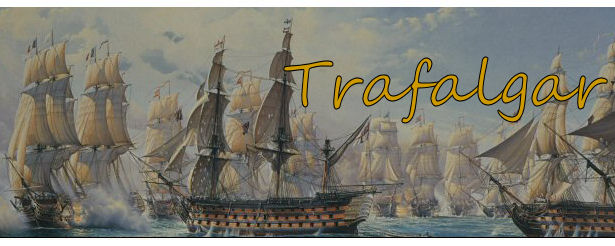
Trafalgar: The Aftermath and the Hurricane
Collingwood Takes Command
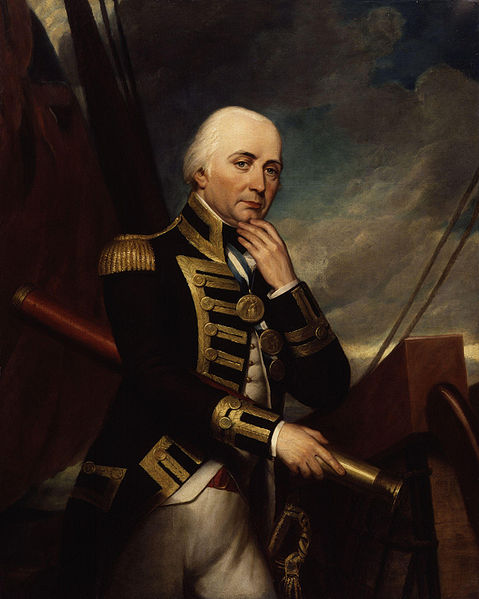
Late in the afternoon on the 21st of October 1805, as prisoners were rowed from the destroyed French ship Achille to the British ship, Revenge, Captain Thomas Hardy left the Victory and boarded the Royal Sovereign, bearing the news of the death of Admiral Lord Horatio Nelson to his successor as Commander-in-Chief of the Mediterranean, Admiral Cuthbert Collingwood. Collingwood had been a close friend of Nelson's since they had served together in the Lowestoffe, 28 years earlier. Unlike his emotional friend, Collingwood was known to be reserved, but still was seen to shed tears upon hearing of Nelson's death.
Hardy also passed on Nelson's final instruction: that the fleet must anchor. But Collingwood's reply was, "Anchor, it is the last thing I should have thought of!"
Collingwood had not escaped the battle unharmed, and had a badly wounded leg and had narrowly escaped being killed by a cannonball. Nonetheless, he accepted his role in command without hesitation. In the early evening, as the discipline of the British seamen overrode their exhaustion and they got to work clearing the decks, throwing bodies overboard and making temporary masts and rigging to replace those lost in battle (to the amazement of French officers who were used to their seamen frequently being 'drunk or disabled' after a battle), Collingwood transferred to the Euryalus frigate. The Royal Sovereign's masts had been destroyed in the battle so he couldn't fly signals from them - a bit of a handicap for a commander required to issue orders to a large fleet!
At the start of the battle, the combating fleets had been 18 miles west from Cape Trafalgar, and 22 miles south-south-west from Cadiz. During the hours of battle, the rising swell of the sea had slowly pushed them closer to the coast. Now, the wind was picking up, and the ships, many of which were very badly damaged or even dismasted during the battle, were in danger of being unable to avoid the shallow waters. This was what Nelson, with his carefully-developed innate sense for the changes of the weather in this part of the sea, had foreseen, and he had known that by anchoring, the fleet could have ridden out the worst of the storm in relative safety.
But it wasn't as simple as that. Many of the ships needed urgent repairs just to stay seaworthy, and there was also the problem of the small enemy squadron that had escaped to Cadiz. If they were to return, they could cause a lot of damage to the limping, exhausted fleet, and there was also the possibility of enemy cruisers running into them. Though the swell and the wind were picking up, there didn't seem to be an immediate danger of being pushed against the rocks. On balance, Collingwood decided that the rocks did not present as big a danger as the enemy and damage to the ships, and so he made the decision to sail for Gibraltar, away from Cadiz.
The Storm's First Victims

As the wind began to pick up, the disabled ships were taken in tow, and the fleet began to move slowly around Cape Trafalgar. The plan was to make it round the shallows before the storm reached its peak. But in the event, only the Belleisle, and the Naiad which was towing her, made it round before the storm ended, and even they were nearly wrecked. No one (except, perhaps, Nelson) could have predicted how fast the storm would come on, and how ferocious it would be.
By midnight, many ships were already dangerously close to the rocks. The wind, for a short time, changed direction so that they could move away from the shore, but only on a course that made them double-back on themselves and head towards Cadiz. But the wind changed direction often as it grew stronger and stronger, until it became hurricane-strength. It was accompanied by torrential rain and lightning, and the sky was so thick with clouds that for a week the sun, moon and stars were obscured. It was impossible to pull away from the coast completely, and the seamen still had to try to work to repair the ships.
It was around midnight that the storm took its first victims. The French ship Fougueux had been so badly damaged during the battle that she had to be towed by the British frigate, Phoebe. She had lost her masts and rigging, so was utterly disabled, and to make matters worse, she had several large battle wounds in the form of holes through which the churning water poured faster than it could be pumped back out. As the storm increased in intensity, the tow rope between her and Phoebe snapped. The crew of the Phoebe tried to get a new line to the Fougueux, but found it impossible. Eventually, the French ship was thrown against the rocks and broken up, killing nearly the whole crew and the British boarding party that had been sent from the Temeraire to take control of her.
Preservation of Nelson's Body
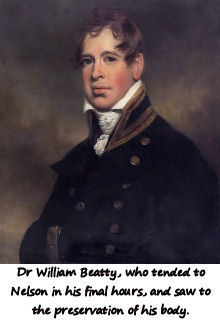 Though the winds didn't lessen, all the ships survived the next day, though with
difficulty. Onboard Victory, Nelson's body was carefully prepared,
by Dr Beatty, for his funeral. As it wouldn't return to England for
several weeks, it had to be preserved. His hair was cut off in order to
obey his instruction to give it to Emma, and all his clothes were removed except
for his shirt. It's possible that women assisted in the preparation of the
body. It's thought that there were several women on board, despite
Nelson's insistence that there should be none, though it is hard to know for
sure as they weren't entered on any official record and their existence is only
know of through witness accounts and the women's own tales. Indeed, one
woman claimed to have washed the blood from Nelson's shirt.
Though the winds didn't lessen, all the ships survived the next day, though with
difficulty. Onboard Victory, Nelson's body was carefully prepared,
by Dr Beatty, for his funeral. As it wouldn't return to England for
several weeks, it had to be preserved. His hair was cut off in order to
obey his instruction to give it to Emma, and all his clothes were removed except
for his shirt. It's possible that women assisted in the preparation of the
body. It's thought that there were several women on board, despite
Nelson's insistence that there should be none, though it is hard to know for
sure as they weren't entered on any official record and their existence is only
know of through witness accounts and the women's own tales. Indeed, one
woman claimed to have washed the blood from Nelson's shirt.
There was no lead on board in order to make a coffin, and so he was put in a large cask full of brandy, which would act as a preservative, and was guarded by marines. A legend arose, that still persists today, that the cask was actually full of rum, and that the guards siphoned it off to drink. Navy-issue rum was afterwards nicknamed 'Nelson's Blood'. (Incidentally, a type of rum of that name is available today. I've tried some - it's a little strong for me!). A little of the brandy was removed at intervals in order to replace it with fresh brandy, but it's not likely that anyone drank it. At one point, the cask swelled alarmingly due to the natural release of gases from the body, and the lid had to be opened a little to let it out.
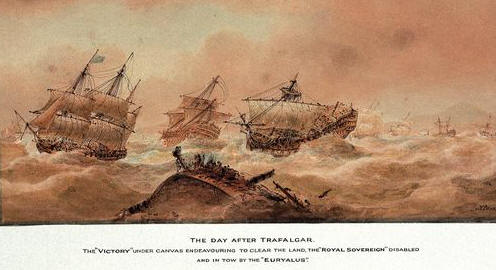
The End of the Redoutable
The fleet may have survived the day of the 22nd October, but the evening saw more casualties. The French Redoutable, the ship that had caused such devastation to Victory and from which a sniper had delivered the fatal shot to Nelson, was in trouble. She had been all but destroyed in the battle and so was being towed by the British Swiftsure, but began taking on a lot of water as the storm worsened. Captain Lucas, along with two of his officers, had been taken aboard Swiftsure as prisoners earlier in the day. But now, his ship began to make distress signals to the Swiftsure, which began sending boats out to rescue men from the doomed ship. They managed to rescue the British party onboard, as well as several of the prisoners, but it soon became clear that it was too dangerous to send out anymore boats. At around 10:15 in the evening, Redoutable sank. Men in the Swiftsure were subjected to the horror of hearing cries for help from the men going down with their ship, but were unable to do a thing to help them.
The Loss of the Algésiras

The French Algésiras had surrendered to the Tonnant during the battle, and a party of fifty men led by Lieutenant Charles Bennett had been sent on board to take possession of her. But she had suffered a lot of damage, and Bennett found it impossible for his fifty men to repair the damage. During the day of the 22nd, he fired several distress signals, but no British ship came to help. By the early evening, Algésiras had been driven dangerously close to the rocks. The lack of help from the British led the French crew to abandon their honourable obligation to remain prisoners after their surrender, as they felt they should have been entitled to protection from their captors. They decided to take back the ship, and Bennett and his men surrendered to them without putting up a fight and causing any more injury or loss of life.
The French crew got to work making rudimentary repairs, and managed to rig a couple of sails to the stumps that were all that remained of the masts. There was only one anchor, and that was broken, but the crew managed to fix it to such a condition that it was at least usable. Now able to manoeuvre her to some extent, they managed to get Algésiras close to Cadiz lighthouse, and were able to anchor there in relative safety.
At daylight the next day, having safely ridden out the night, Algésiras found herself to not quite be within the harbour, and still close to the rocks. Having only one anchor, her position was precarious. Boats from Cadiz were sent to try to help, but the weather prevented them from getting close.
At around 10pm, the anchor cable snapped, and disaster was narrowly avoided when Algésiras nearly collided with another drifting ship. Fortunately, as it turned out, she became stuck on rocks in the shallows, and sat there for the night.
On the 24th, the weather was a little better, and Spanish boats from Cadiz were able to bring a new anchor and cable to the Algésiras. They tried to pull her off the rocks, but she was stuck fast. The crew lightened the ship by throwing guns and other unnecessary items overboard. Thus, as tide rose in its usual way in the evening, and the wind was fortuitously blowing in an advantageous direction, she was blown over the rocks and into the harbour. The British had lost a prize, but their boarding party and the few hundred French seamen, had not lost their lives.
Cosmao Returns
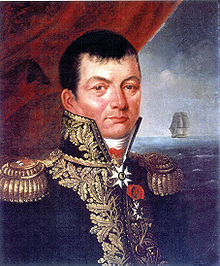
On the morning of the 23rd, Captain Cosmao-Jerjulien (pictured left), who had escaped to Cadiz, decided to come back to retake some of the captured French and Spanish ships. His ship, Pluton, was very badly damaged, but nevertheless she led the Indomptable, Neptune, Rayo, San Francisco de Asis, and the frigates Cornélie, Hermione, Hortense, Rhin and Themis.
When he left Cadiz, the wind direction was perfect for bearing down upon the British, and was also less fierce. But that didn't last long, and it soon turned against him and began to pick up. The rain and spray from the sea made visibility poor, and as Cosmao's ships came into view of the British, they mistook his frigates for battleships, and thought that his fleet was bigger than it actually was, and 11 ships began to manoeuvre into a line of battle to meet them. In so doing, they had to abandon two of their prizes: Santa Ana and Admiral Villeneuve's former flagship, Bucentaure.
Bucentaure was abandoned by Conquerer as the British ship got into line and, uncontrollable due to the damage she'd sustained, she began to drift towards the shore. French and Spanish boats from Cadiz harbour managed to rescue most of the French seamen from Bucentaure, as well as the British boarding party, and took them onboard the Indomptable. But, sadly, that ship was not enough to save them for, shortly after Bucentaure was wrecked, she ran aground and gradually broke up. Out of the 1000 souls by that time on board, only 100 survived.
They were not the only ships to meet a sorry fate. San Francisco de Asis, one of the ships Cosmao had brought with him from Cadiz, had to anchor outside the harbour, but her anchor cables broke and she too was wrecked. Rayo couldn't make it back into Cadiz, either, and anchored a few miles away. She was dismasted during the storm, but survived.
The British ships formed their line, blocking off the rest of their prizes and, with the weather also against him, Cosmao decided he didn't want to fight, and went back to Cadiz. The only ship that he was successful in rescuing was the Santa Ana. But in doing so, he lost two of the ships he'd started with, and indirectly caused the wreck of another. Still, he was later praised for his actions, and Napoleon called him "The best sailor of the time; none was ever braver and more generous."
Meanwhile, the British party aboard their prize, the former Spanish ship Neptuno, upon seeing Cosmao's little fleet, tried to join the British line as it was forming. But the crew, believing they would be rescued, rose up and took back control of the ship. One of Cosmao's ship, the frigate Hortense, got to Neptuno and started to tow her towards Cadiz. But they were stuck outside the harbour all night, and in the morning the anchor cable snapped and she was driven ashore. The British prisoners helped the Spanish to build rafts to get everyone off the ship and, aside from some that drowned when the raft capsized once, they managed to get almost all of those onboard the ship, to safety.
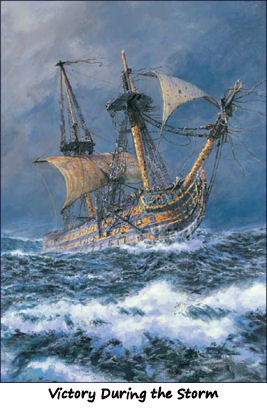
'Prepare to Quit'
At 8.30am on the 24th, Admiral Collingwood flew the signal 'Prepare to quit and withdraw men from prizes after having destroyed or disabled them if time permits'. The storm was not abating, and the men were by now beyond exhausted. It was becoming virtually impossible to repair the most damaged ships, and it was proving to be fatal to remain on them. Collingwood decided to cut his losses and save the British ships and crew, even if meant losing their prizes. But he would at least have them destroyed so the enemy couldn't get them back. In the circumstances, there was very little else he could do.
But nature hadn't finished with them yet.
Continued Tragedy
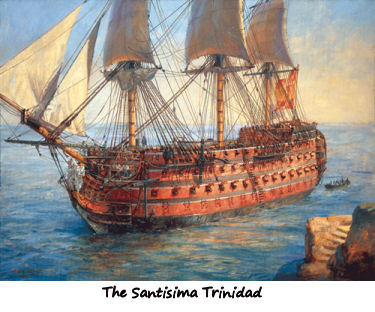
The majestic Spanish giant, Santisima Trinidad, had been difficult to keep afloat since the battle, to the point that the crew hadn't even had opportunity to clear the decks of blood and body parts. Towed by the Prince, she was boarded by British men from that ship as well as from Neptune and Ajax. On the 24th, realising that she was sinking, they began to abandon ship, and men were lowered by rope from the stern to get into the boats. All but 30, who were deemed too badly wounded to move, were rescued, and only ten minutes after the last boat left, the largest battleship in the world sank.
Meanwhile, the Spanish Monarca, which had been boarded by a small British crew, found herself dismasted and close to the rocks. The Spanish seamen were exhausted and gave up trying to pump water out of the ship, and prepared to let her run aground. But in the morning, as the weather was a little better, they raised their hopes again and got back to work on the pumps.
Nearby, the Rayo, one of Cosmao's ships, remained anchored and dismasted. The British Leviathan came up and fired a single shot, to which the Rayo surrendered without a fight. The men aboard Monarca were evacuated to Leviathan, with the exception of about 150 Spanish who were too afraid to get into the boats. Monarca and Rayo were left at anchor as they were too badly damaged to move in such bad weather. But both of their anchor cables snapped, and on the morning of the 25th Monarca was wrecked, with Rayo following her on the 26th.
The French Aigle, having surrendered to the British Defiance during the battle, was drifting away from the fleet after the British crew had failed to set up a tow rope. During the night of the 24th, the French crew overpowered their British captors and took back the ship, and managed to get her close to the harbour, but in the morning she scraped on rocks and lost her rudder. Uncontrollable, Aigle ran aground and was wrecked.
Intrépide, abandoned by the British Britannia which had to join the line against Cosmao, was leaking badly. Giving up hope, the French crew abandoned the pumps and broke into the storeroom to get drunk instead. Luckily, the British Orion passed nearby and was hailed by the prize crew. She was able to take men off Intrépide, and the prize was set on fire. The San Augustin was also burned, and Argonauta was scuttled.
Captain Malcolm and the Donegal
 Special
mention here goes to Captain Pulteney Malcolm of the Donegal. He
had just returned from Gibraltar with supplies, and upon arriving took
possession of the doomed Rayo before anchoring. He saw the French
Berwick anchored nearby with a British prize crew onboard.
Suddenly, and inexplicably, the French prisoners cut the Berwick's anchor
cables, and she began to be driven by the wind towards the rocks. Taking a
big risk to his own ship, but unable to sit back and watch the men aboard
Berwick be killed without trying to help, he had Donegal's cables
cut, and went after her. He sent boats to rescue first the French wounded,
then the British prize crew. But he couldn't save many more before
Berwick hit the rocks, and 300 men were killed.
Special
mention here goes to Captain Pulteney Malcolm of the Donegal. He
had just returned from Gibraltar with supplies, and upon arriving took
possession of the doomed Rayo before anchoring. He saw the French
Berwick anchored nearby with a British prize crew onboard.
Suddenly, and inexplicably, the French prisoners cut the Berwick's anchor
cables, and she began to be driven by the wind towards the rocks. Taking a
big risk to his own ship, but unable to sit back and watch the men aboard
Berwick be killed without trying to help, he had Donegal's cables
cut, and went after her. He sent boats to rescue first the French wounded,
then the British prize crew. But he couldn't save many more before
Berwick hit the rocks, and 300 men were killed.
"May humanity after Victory be the predominant feature in the British Fleet," had been Nelson's wish as he wrote his 'Trafalgar Prayer' before the battle, and Captain Malcolm certainly fulfilled that wish. The wounded French were given cots and bedding at the expense of the British and, with that bedding to make their journey as comfortable as possible, were sent into Cadiz under a flag of truce, where they could receive treatment. The Donegal then anchored off Cadiz.
The Aftermath
The aftermath of the hurricane presented a far bleaker picture of tragedy and devastation than the battle had done. Only one ship, the French Achille, had been destroyed during the battle. In the week that followed, 14 of the prizes taken by the British were destroyed. The loss of life had been horrendous, far more than during the battle. Only four of the prizes remained in possession of the British - Bahama, San Ildefonso, San Juan Nepomuceno, and Swiftsure, and these were sent to Gibraltar. In the end, with the addition of Cosmao's ships which were wrecked, Nelson almost got his wish of 20 ships destroyed or taken.
Even as long as 10 days after the battle, bodies and wreckage were still being washed ashore at Cadiz. Because the British showed humanity in returning the Spanish prisoners, the Spanish were happy to help them, and the hospitals were soon full of British wounded along with the French and Spanish. Besides, the Spanish and British had never really hated each other like they did the French, and it isn't likely that Spain would have allied with France at all if it weren't for the pressure Napoleon put them under.
Admiral Collingwood set about returning to some semblance of a normal duty, arranging for exchanges of prisoners, and organising a blockade of the Cosmao's ships. The British succeeded in keeping them there until 1808, when Napoleon invaded Spain, and the Spanish army took the ships to use against the French.
Victory went to Gibraltar for repairs and for her wounded to receive treatment. From there, she sailed to England, taking Horatio Nelson on his final journey.
Copyright Vicki Singleton 2013.